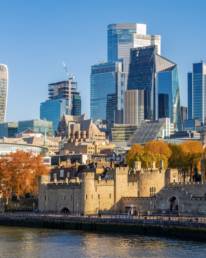Parents always want to give their children the best start in life. That could mean making investment decisions now that will pay off in the longer term, like saving for educational fees, or building up a sum of money that will help your child achieve their future life goals.
Unless you have large sums of money already available to pay for school fees, university or a house deposit, you’ll need to start investing for your child’s future as soon as possible.
For new parents, at least you have the comfort that starting early should help you to grow the investment over time, hopefully building up a meaningful sum for whenever your child needs it. So, let’s consider some of the financial challenges that new parents might face, as well as some of the investment options open to you.
If the ‘bank of mum and dad’ was an actual bank, it would be one of the top ten lenders operating in the UK today
Giving your child the best education
A private school education has always been one of the most popular ways for parents to invest in their child’s future. But it’s an expensive option.
According to the latest report published by the Independent Schools Council (ISC), the average fee for a child to attend a private day school is currently around £15,655 a year, or roughly £5,200 for each school term. Of course, the school fees are just one part of paying for a private education. Parents should probably expect to pay total costs of between £150,000 and £200,000 for their child to attend a private day school, and double that amount for a boarding school.
You’ll also need to consider paying for your child to go to university. A three-year course today costs an average of £9,250 per year, or £27,750 over three years. That’s not including accommodation and living expenses, which could cost around £12,200 a year, depending on which university they attend.
Saving for a house deposit
The other major financial consideration for most parents now, is whether they’ll be able to give their children a head-start on the property ladder. This might include helping them with their living expenses during the early years of their career, and then providing them with a deposit for a place of their own later on.
In fact, if the ‘bank of mum and dad’ was an actual bank, it would be one of the top ten lenders operating in the UK today. Parents often choose to give money to their children as a gift, although some describe it as a ‘no interest’ loan, and some ask their children to pay a rate of interest on any money borrowed.
It’s worth noting that in March 2022, the average house price stood at £278,000, which was a £24,000 increase on prices in 2021. Most lenders will expect first-time buyers to have a 10% deposit (although a 20% deposit would give the homebuyer access to better mortgage deals). This means that at today’s prices, helping your child to get on the property ladder would require an outlay somewhere in the region of £27,800 to £55,600, depending on the size of the property and its location.
What about other life essentials?
If you want your children to feel personally invested in their financial future, or want to support them with purchases like a first car or gap-year travel in their later teens, you should consider opening a Junior ISA (JISA) on their behalf. You can invest up to £9,000 a year into a JISA, which works out at £750 a month, and you can choose to invest either in a Cash JISA or a Stocks & Shares version.
With regular deposits from an early age, your child could potentially build a significant pot of money by the time they reach adulthood. But parents should be aware that because the JISA is held in the child’s name, they will become the legal owner when they turn 18.
Investing in a Stocks & Shares ISA should give your money a better chance of generating a greater return over the long term
Tax-efficient investing through an ISA
If you’re planning to invest over several years to achieve a longer-term goal, such as paying for the cost of education or helping with a home deposit, you should really start by maximising your annual Individual Savings Account (ISA) allowances.
With an ISA, you can personally invest up to £20,000 each tax year – or £40,000 per couple – without paying any tax on the growth of your investment. There are different versions of the ISA available, depending on how much risk you’d like to take with your money.
Although interest rates are heading upwards, we’re still living in an era where cash savings accounts pay a low rate of interest. When you add high levels of inflation to the mix, it could mean those savings actually lose money, in real terms. This currently makes Cash ISAs a far less attractive option for people looking to grow their savings.
You might instead choose to invest in a Stocks & Shares ISA, which should give your money a better chance of generating a greater return over the long term. However, it’s worth remembering that money withdrawn from your ISA will lose its tax benefits, and that investments can go up as well as down, so there’s a risk you may not get back the full amount invested.
General Investment Accounts
If you’re worried about what your 18-year-old would do with all that money in their JISA, then investing in a General Investment Account (GIA) might offer an alternative. A GIA is similar to an ISA in terms of the types of investments it can hold, and there’s no limit to the amount you can invest each year.
However, a GIA doesn’t offer any ISA-style tax breaks, which means you will pay income tax and capital gains tax on your investment returns. Crucially though, the GIA is held in your name, not your child’s, so you get to decide how the money is spent.
The cost of nursery and childcare
Once you’ve overcome those first few months, you’ll probably need to start thinking about nursery costs and childcare. And this is when the costs really start adding up. According to the Family and Childcare Trust, a part-time nursery place (25 hours) for a child under the age of two costs £138.00 per week – that’s more than £7,000 per year.
However, the government does step in to help as your child gets older. All three- to four-year olds can get up to 15 hours per week of free childcare. And in 2017, the government introduced its Tax-Free Childcare scheme, which offers up to £2,000 a year (per child) towards childcare costs like nursery, childminding and other care – such as caring for a disabled child.
With this scheme, parents pay money into an online account and the government adds a top-up. You can then use the account to pay for childcare from registered childcare providers. The scheme is open to both the employed and the self-employed, but you’ll need to earn at least £152 a week and less than £100,000 a year to qualify for it.
If you really want to think long-term for your child, you could consider setting up a Junior Self-Invested Pension
Trusts and investment bonds
There are other ways to make financial plans for your child’s future. For example, the ‘trustees’ of a bare trust (often parents or grandparents) can invest on the child’s behalf, and make withdrawals from the trust when school or university fees become payable.
Alternatively, an investment bond is structured with different slices or segments, which then allows you to gift some segments to other people. This means you can place a segment of the bond in your child’s name, and withdraw money tax-efficiently when necessary.
Junior pensions
If you really want to think long-term for your child, you could consider setting up a Junior Self-Invested Pension (or JSIPP) on their behalf. This is an option often considered by parents who have used up ISA and JISA allowances.
The maximum annual amount that can be invested into a JSIPP is £3,600. But thanks to pension relief, a parent would only need to pay in £2,880 to reach that upper limit, and the government would contribute the rest.
The downside, of course, is that your child won’t be able to access their pension until they reach the minimum retirement age – which will be age 57 from 2028. But it could be helpful in setting them up with a retirement pot and encouraging them to make investments of their own. And with an investment timeframe of more than 50 years, even small amounts put into the JSIPP can grow significantly over decades.
Life Landscaping® from Amber River
Making financial plans for your child’s future can sound daunting, especially when you start adding up all the costs involved. It can be difficult to know where to start, or how much you should set aside while still taking care of your day-to-day needs.
At Amber River, we can help by working out your current priorities and your future goals. We’ll offer straightforward financial planning that allows you to create a life plan, setting you and your family on the path towards a bright future.
Get in touch
To speak to one of our team, arrange an appointment or find out more, call 0800 915 0000, or alternatively use our contact form here.
Disclaimer
The information within this article was correct at the time of publishing, but laws and tax rules are subject to change. Your circumstances and where you live in the UK may also have an impact on your tax treatment.
Related Posts
3 October 2025
Read More

8 July 2025
Read More

8 July 2025
Read More

24 February 2025
Read More

6 January 2025
Read More

12 April 2024
Read More

